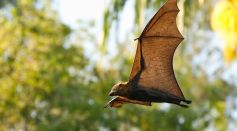ENVIRONMENT & CLIMATE

Echolocation: How Do Animals Like Bats Use This Hunting Technique For Survival by Predicting Prey Movement?

Great Oxygenation and Plankton Eradication Paved the Way For Mountains and Life on Earth
Sun a 'Surprising Source' of Unexplained Water on Earth: What is Solar Wind Theory?
Ethiopian Elephant Population Under Threat; Research Shows How Illegal Housings Put the Largest Land Animals at Risk
How Can Ecosystem Benefit From Wildfires? The Right Level of Catastrophe Help Shape Ecology

Denisovans: 200,000 Year Old Human Fossils Unearthed in SIberia
Scientists Witness the ‘Best Coral Spawning Event’ on the Great Barrier Reef, Hope for ‘Recovery and Repair’ in Marine Organisms

800-Year Old Peruvian Mummy Unearthed Rope-Bound in Cajamarquilla

Mammoth Tusks Dating Back to 100,000 Years Ago Unearthed Off the Coast of California
Himalayas Tibetan Plateau Unique Tectonic Construction Uncovered; What's Behind It's Decades-Long Mystery?

Possibilities of Life for Organisms at the Bottom of the Ocean, Other Planets Aside from Earth Discovered
Dinosaur Skeleton Unearthed: Scientists Say the Missouri Discovery Belongs to the Hadrosauridae Family

Humans May Have Broken the Natural Law Adversely Affecting the Global Ocean

Monogamous Albatross Forced To Divorce Due To Climate Change and Warming Water Instead of Breeding Failure
Most Popular

Will Earth's Magnetic Poles Flip Next? Magnetic Pole Reversal Explained Through Cutting‑Edge Magnetosphere Science

How Lightning Science Reveals Why Charged Storms Are Rising with Global Warming Effects

Relativity Time Dilation Explained: The Physics of Time and Why It Moves Differently in Space

Earthquake Magnitude vs Intensity: Key Differences Explained for Accurate Measurement





